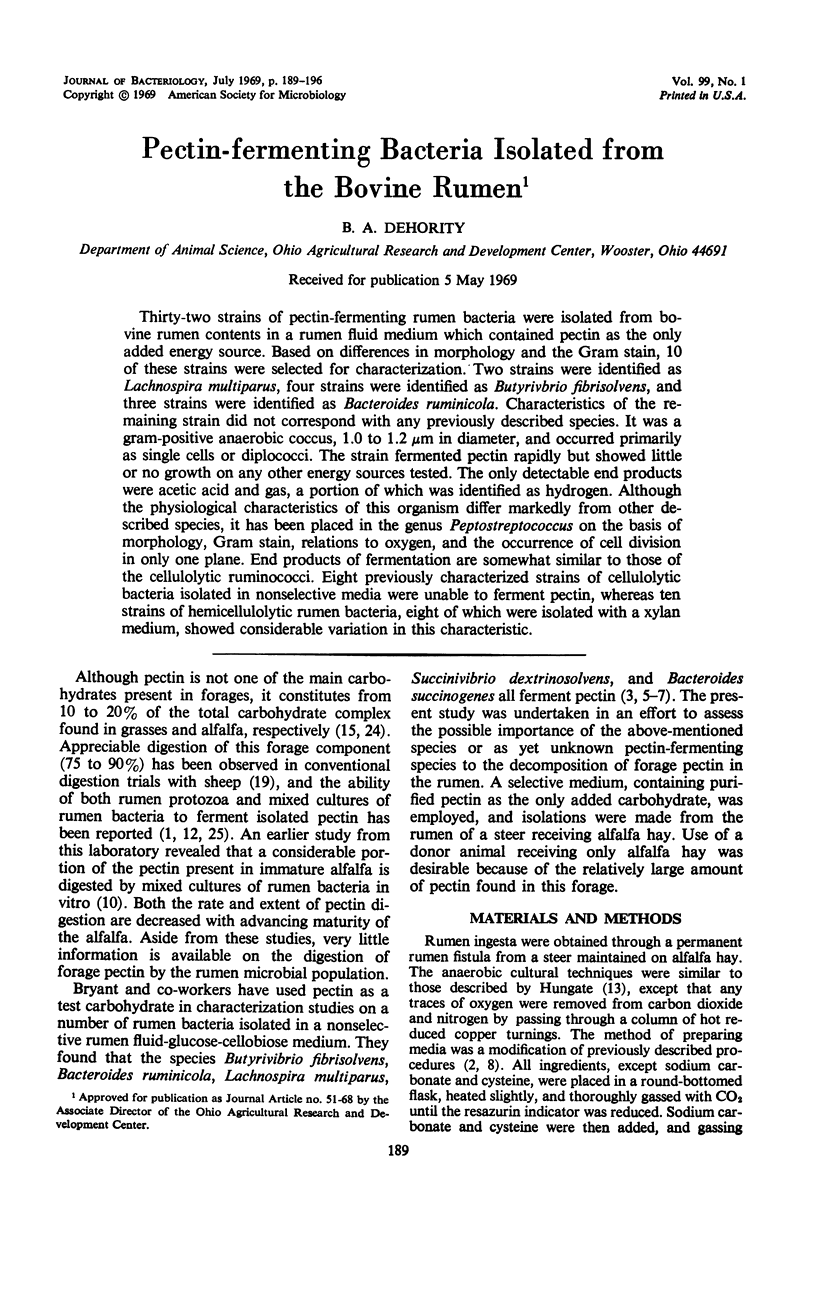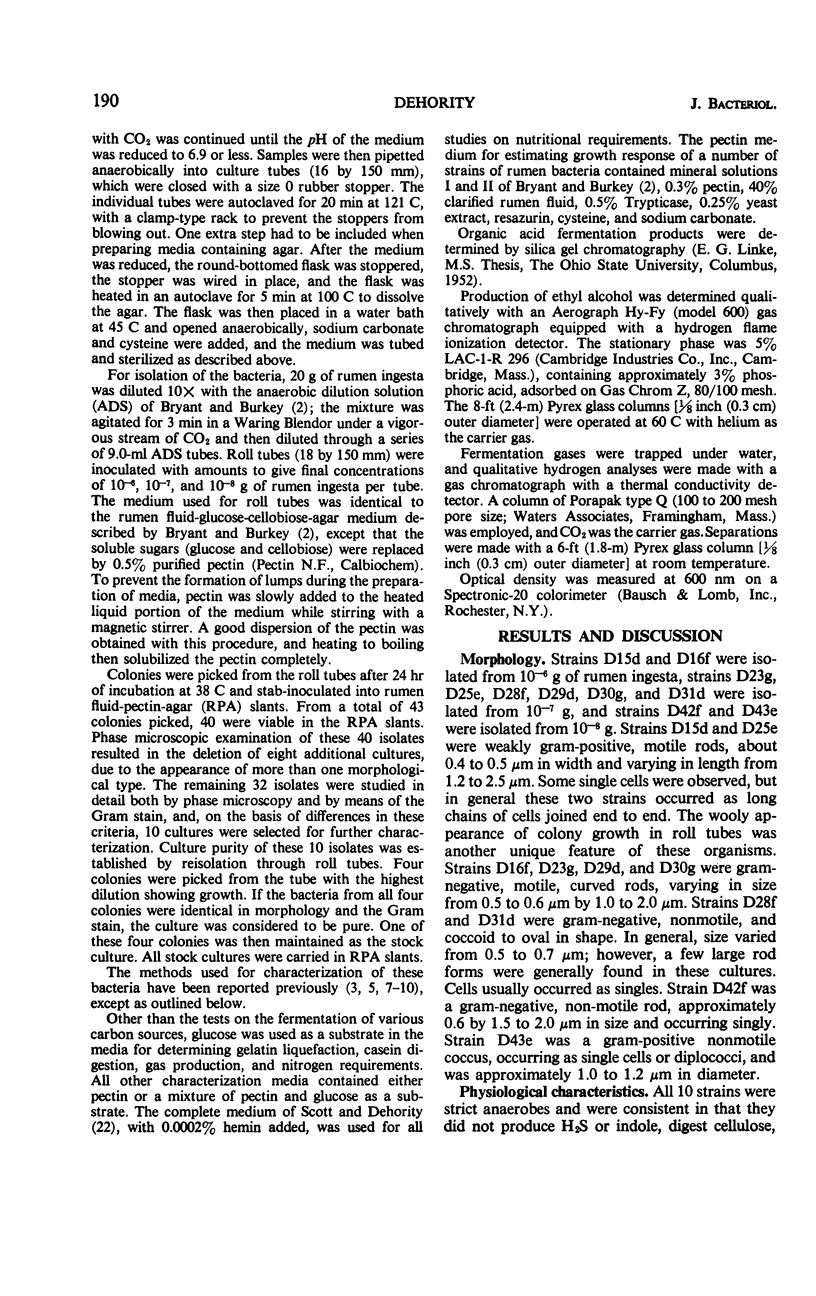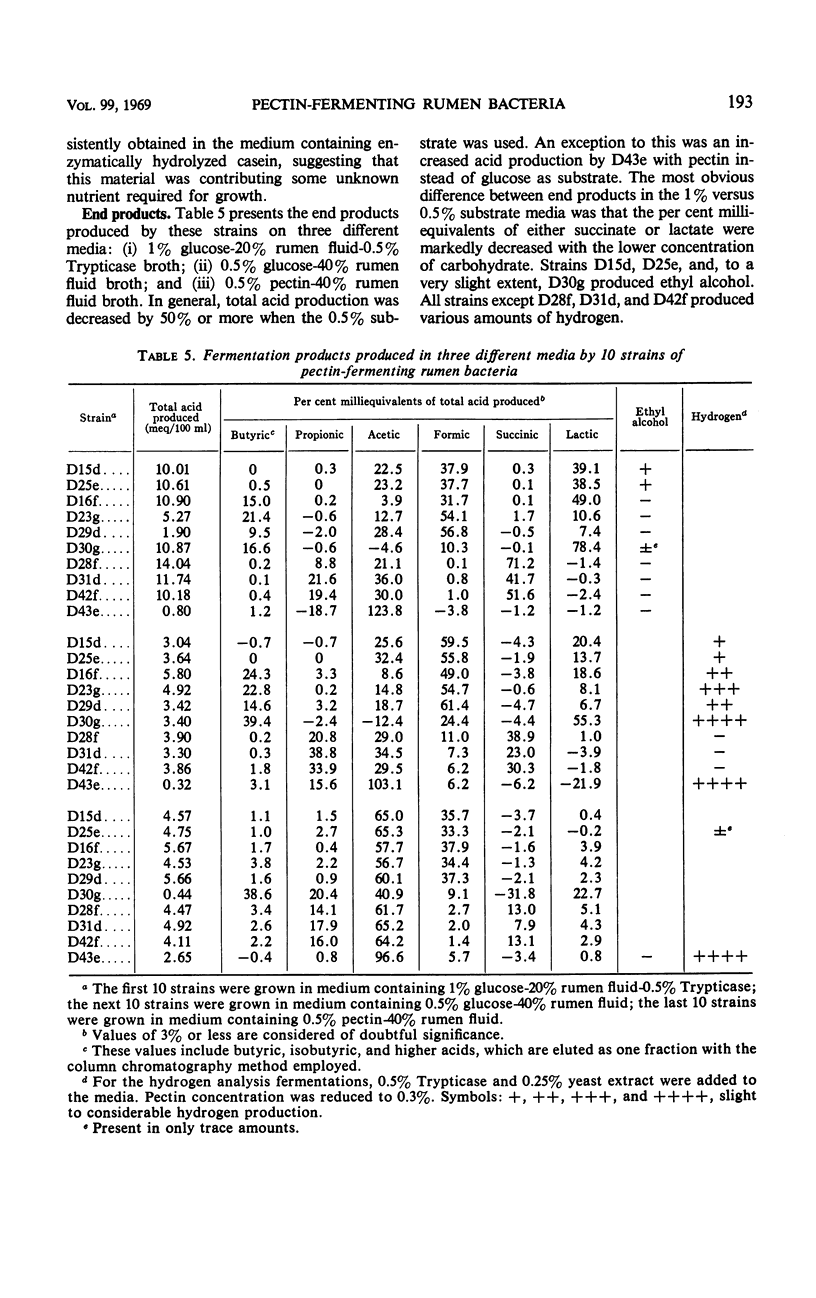Abstract
Thirty-two strains of pectin-fermenting rumen bacteria were isolated from bovine rumen contents in a rumen fluid medium which contained pectin as the only added energy source. Based on differences in morphology and the Gram stain, 10 of these strains were selected for characterization. Two strains were identified as Lachnospira multiparus, four strains were identified as Butyrivbrio fibrisolvens, and three strains were identified as Bacteroides ruminicola. Characteristics of the remaining strain did not correspond with any previously described species. It was a gram-positive anaerobic coccus, 1.0 to 1.2 μm in diameter, and occurred primarily as single cells or diplococci. The strain fermented pectin rapidly but showed little or no growth on any other energy sources tested. The only detectable end products were acetic acid and gas, a portion of which was identified as hydrogen. Although the physiological characteristics of this organism differ markedly from other described species, it has been placed in the genus Peptostreptococcus on the basis of morphology, Gram stain, relations to oxygen, and the occurrence of cell division in only one plane. End products of fermentation are somewhat similar to those of the cellulolytic ruminococci. Eight previously characterized strains of cellulolytic bacteria isolated in nonselective media were unable to ferment pectin, whereas ten strains of hemicellulolytic rumen bacteria, eight of which were isolated with a xylan medium, showed considerable variation in this characteristic.
Full text
PDF







Images in this article
Selected References
These references are in PubMed. This may not be the complete list of references from this article.
- ABOU AKKADA A. R., HOWARD B. H. The biochemistry of rumen protozoa. 4. Decomposition of pectic substances. Biochem J. 1961 Mar;78:512–517. doi: 10.1042/bj0780512. [DOI] [PMC free article] [PubMed] [Google Scholar]
- BRYANT M. P., ROBINSON I. M. Some nutritional characteristics of predominant culturable ruminal bacteria. J Bacteriol. 1962 Oct;84:605–614. doi: 10.1128/jb.84.4.605-614.1962. [DOI] [PMC free article] [PubMed] [Google Scholar]
- BRYANT M. P., SMALL N., BOUMA C., CHU H. Bacteroides ruminicola n. sp. and Succinimonas amylolytica; the new genus and species; species of succinic acid-producing anaerobic bacteria of the bovine rumen. J Bacteriol. 1958 Jul;76(1):15–23. doi: 10.1128/jb.76.1.15-23.1958. [DOI] [PMC free article] [PubMed] [Google Scholar]
- BRYANT M. P., SMALL N. Characteristics of two new genera of anaerobic curved rods isolated from the rumen of cattle. J Bacteriol. 1956 Jul;72(1):22–26. doi: 10.1128/jb.72.1.22-26.1956. [DOI] [PMC free article] [PubMed] [Google Scholar]
- BRYANT M. P., SMALL N. The anaerobic monotrichous butyric acid-producing curved rod-shaped bacteria of the rumen. J Bacteriol. 1956 Jul;72(1):16–21. doi: 10.1128/jb.72.1.16-21.1956. [DOI] [PMC free article] [PubMed] [Google Scholar]
- DEUEL H., STUTZ E. Pectic substances and pectic enzymes. Adv Enzymol Relat Subj Biochem. 1958;20:341–382. doi: 10.1002/9780470122655.ch11. [DOI] [PubMed] [Google Scholar]
- Dehority B. A. Characterization of several bovine rumen bacteria isolated with a xylan medium. J Bacteriol. 1966 May;91(5):1724–1729. doi: 10.1128/jb.91.5.1724-1729.1966. [DOI] [PMC free article] [PubMed] [Google Scholar]
- HUNGATE R. E. Microorganisms in the rumen of cattle fed a constant ration. Can J Microbiol. 1957 Mar;3(2):289–311. doi: 10.1139/m57-034. [DOI] [PubMed] [Google Scholar]
- HUNGATE R. E. The anaerobic mesophilic cellulolytic bacteria. Bacteriol Rev. 1950 Mar;14(1):1–49. doi: 10.1128/br.14.1.1-49.1950. [DOI] [PMC free article] [PubMed] [Google Scholar]
- LAGOWSKI J. M., SELL H. M., HUFFMAN C. F., DUNCAN C. W. The carbohydrates in alfalfa Medicago sativa. I. General composition, identification of a nonreducing sugar and investigation of the pectic substances. Arch Biochem Biophys. 1958 Aug;76(2):306–316. doi: 10.1016/0003-9861(58)90156-5. [DOI] [PubMed] [Google Scholar]
- LANIGAN G. W. Studies on the pectinolytic anaerobes Clostridium flavum and Clostridium laniganii. J Bacteriol. 1959 Jan;77(1):1–9. doi: 10.1128/jb.77.1.1-9.1959. [DOI] [PMC free article] [PubMed] [Google Scholar]
- MACMILLAN J. D., PHAFF H. J., VAUGHN R. H. THE PATTERN OF ACTION OF AN EXOPOLYGALACTURONIC ACID-TRANS-ELIMINASE FROM CLOSTRIDIUM MULTIFERMENTANS. Biochemistry. 1964 Apr;3:572–578. doi: 10.1021/bi00892a017. [DOI] [PubMed] [Google Scholar]
- MACMILLAN J. D., VAUGHN R. H. PURIFICATION AND PROPERTIES OF A POLYGALACTURONIC ACID-TRANS-ELIMINASE PRODUCED BY CLOSTRIDIUM MULTIFERMENTANS. Biochemistry. 1964 Apr;3:564–572. doi: 10.1021/bi00892a016. [DOI] [PubMed] [Google Scholar]
- NG H., VAUGHN R. H. CLOSTRIDIUM RUBRUM SP. N. AND OTHER PECTINOLYTIC CLOSTRIDIA FROM SOIL. J Bacteriol. 1963 May;85:1104–1113. doi: 10.1128/jb.85.5.1104-1113.1963. [DOI] [PMC free article] [PubMed] [Google Scholar]
- PITTMAN K. A., BRYANT M. P. PEPTIDES AND OTHER NITROGEN SOURCES FOR GROWTH OF BACTEROIDES RUMINICOLA. J Bacteriol. 1964 Aug;88:401–410. doi: 10.1128/jb.88.2.401-410.1964. [DOI] [PMC free article] [PubMed] [Google Scholar]
- SCOTT H. W., DEHORITY B. A. VITAMIN REQUIREMENTS OF SEVERAL CELLULOLYTIC RUMEN BACTERIA. J Bacteriol. 1965 May;89:1169–1175. doi: 10.1128/jb.89.5.1169-1175.1965. [DOI] [PMC free article] [PubMed] [Google Scholar]
- WRIGHT D. E. Pectic enzymes in rumen protozoa. Arch Biochem Biophys. 1960 Feb;86:251–254. doi: 10.1016/0003-9861(60)90413-6. [DOI] [PubMed] [Google Scholar]



